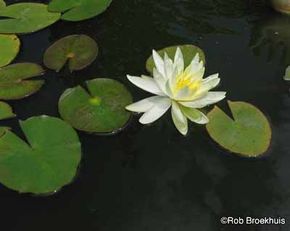Hardy water lily result from crosses between European and North American species. It is an excellent permanent residents of water gardens. Many pools are designed specifically around their culture.
Description of hardy water lily: Hardy water lilies produce round, leathery leaves up to 1 foot across. They can be green or splashed with brown. Their multi-petaled flowers measure up to 12 inches across and come in white, pink, yellow, and red. Many have flowers that change color as they age, and most are lightly scented. The flowers open in the morning and close at night. Unlike tropical water lilies, the flowers of hardy water lilies float on the surface of the water, and the plants grow from rhizomes, not tubers. Ease of care of hardy water lily: Easy.
Advertisement
Growing hardy water lily: To bloom well, hardy water lilies require abundant sunlight (at least 6 hours a day). Plant the rhizome in a large container at a 45 degree angle with only the tip exposed. Set the container in the pool so it is covered with 6 to 18 inches of water (more vigorous varieties can be set in deeper sections of the pool). Fertilize regularly. Remove browned leaves in the fall.
Propagating hardy water lily: By division.
Uses for hardy water lily: Hardy water lilies are grown for their attractive leaves and exotic flowers. They also help reduce algae by shading the water in which they grow. Generally, about half the pond's surface area should be covered by water lily leaves.
Related varieties of hardy water lily: The selection of hardy water lilies is vast. Some of the better known varieties are Rose Arey, with clear pink flowers starting early in the season; Comanche, with speckled leaves and flowers that change from yellow to coppery bronze as they mature; and Hermine, one of the smallest hardy white lilies -- an ideal choice for smaller ponds.
Scientific name of hardy water lily: Nymphaea species
Advertisement
